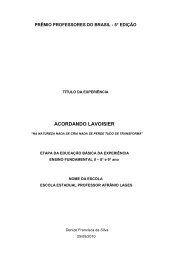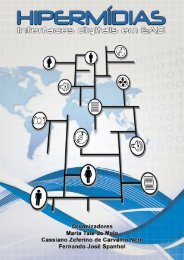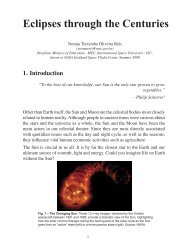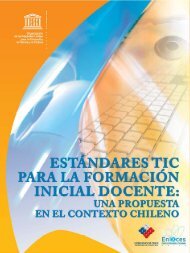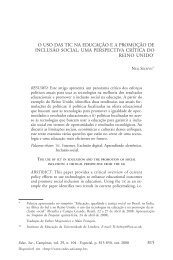BIO-CULTURAL COMMUNITY PROTOCOLS - Portal do Professor
BIO-CULTURAL COMMUNITY PROTOCOLS - Portal do Professor
BIO-CULTURAL COMMUNITY PROTOCOLS - Portal do Professor
Create successful ePaper yourself
Turn your PDF publications into a flip-book with our unique Google optimized e-Paper software.
PART II / CHAPTER 6<br />
There are also many different types of PES deals, ranging<br />
from hundreds of small and private site-specific schemes to<br />
larger government-regulated schemes 15<br />
and multilateral<br />
environmental agreements such as the Clean Development<br />
Mechanism under the Kyoto Protocol.<br />
PES schemes have the potential to be more cost-efficient<br />
than regulatory and subsidized approaches to environmental<br />
conservation that rely heavily on public financial resources<br />
to function. PES schemes usually have flexible and need-based<br />
structures that can support themselves in the long run.<br />
Overall, PES schemes can be more adaptive and effective than<br />
a purely regulatory approach to conservation.<br />
For example, PES schemes can be implemented when the<br />
creation of protected areas would be impossible due to socioeconomic<br />
or political contexts. They are easy to administer<br />
The principle objective of PES schemes is to establish an<br />
economic incentive to foster more efficient and sustainable<br />
use of biological resources and ecosystems. 18<br />
Nevertheless,<br />
PES schemes can also contribute to poverty alleviation,<br />
particularly among rural communities whose livelihoods are<br />
highly dependent on the use of natural resources in<br />
surrounding areas. Population pressures or lack of economic<br />
opportunities based on anything other than short-term<br />
incentives can lead to unsustainable forest management<br />
or farming practices. PES schemes can mitigate this cycle<br />
by offering longer-term incentives for the sustainable use<br />
of resources through opportunities for low-income<br />
communities to gain additional employment or other<br />
economically valuable benefits for their conservation<br />
of ecosystems. Supporting livelihoods through small<br />
economic incentives over many years may offer an<br />
and can be flexible with respect to which land uses are and<br />
are not allowed under its scheme, thus targeting its efforts<br />
towards local conservation and socio-economic<br />
development. 16<br />
In spite of the promising basis of the PES concept, many<br />
PES experts urge caution against accepting it as a panacea,<br />
arguing that the success of PES schemes are highly dependent<br />
on a large set of circumstances and demand substantial<br />
groundwork before they can succeed. In addition to the<br />
concern that PES systems only work in conditions with a<br />
clear market demand, they also seem to rely on well-organized<br />
providers and users with clear and secure property rights.<br />
Furthermore, transaction costs of a PES scheme must not<br />
be too high to offset any potential gains for both the<br />
user(s) and provider(s). 17<br />
3. Community Engagement with PES Schemes<br />
<strong>BIO</strong>-<strong>CULTURAL</strong> <strong>COMMUNITY</strong> <strong>PROTOCOLS</strong> IN THE<br />
CONTEXT OF PAYMENT FOR ECOSYSTEM SERVICES<br />
important increase to net income in the community while<br />
functioning as impetus for a<strong>do</strong>pting a more sustainable<br />
approach to land and ecosystem management. 19<br />
However, it is not always the case that communities engage<br />
in unsustainable use of biological resources. Indeed, many<br />
examples exist in which local communities actively maintain<br />
and conserve the biodiversity on which their livelihoods<br />
and bio-cultural heritage depend. It is often highlighted<br />
how ILCs such as the Raika, discussed earlier in this book,<br />
contribute to and sometimes become leaders in the<br />
conservation of local biodiversity through their sustainable<br />
land use practices. In such cases, PES schemes can offer a<br />
reward for the maintenance of such services and an<br />
acknowledgement of the contribution of their bio-cultural<br />
practices to conservation.<br />
15. See for example the case of Costa Rica: “Payment for Environmental Services and Rural Communities: Lessons from the Americas” Herman Rosa, Susan Kandel,<br />
Leopol<strong>do</strong> Dimas and Ernesto Mendez, PRISMA (Programa Salva<strong>do</strong>reño de Investigación sobre Desarrollo y Medio Ambiente)<br />
16. Supra note 10.<br />
17. Ibid.<br />
18. Supra note 6.<br />
19. Ibid.<br />
60





